Costa Rica has its fair share of coffee farms, and each offers a slightly different experience. While some well-known plantations like Cafe Britt and Starbucks are larger and more commercial, the majority remain small and family run. That is the case with Cafe Don Emilio near Uvita. In this post, we’ll tell you about our visit to this small, family-run coffee farm. It was one of the most authentic coffee tours we’ve ever done.
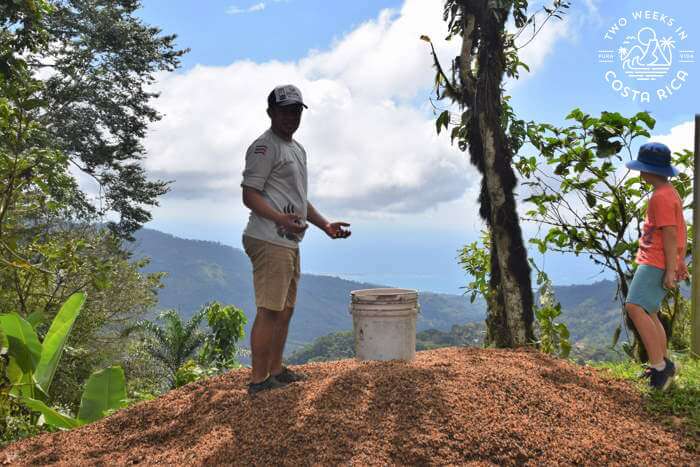
Background
Cafe Don Emilio is located high in the mountains outside Uvita in a small town called San Luis. If you’re visiting Uvita, Dominical, or Ojochal on the southern Pacific coast, it makes a nice day trip.
Once you get off the main highway, you’ll quickly ascend into the mountains. This area is undeveloped for the most part, and peaceful and serene. The road will go from smooth pavement to dirt quickly, with some adventurous inclines. Getting to Cafe Don Emilio is all part of the experience. Once you reach the top of the mountain, you’ll feel far removed from the busyness of the coast.
See driving directions below.
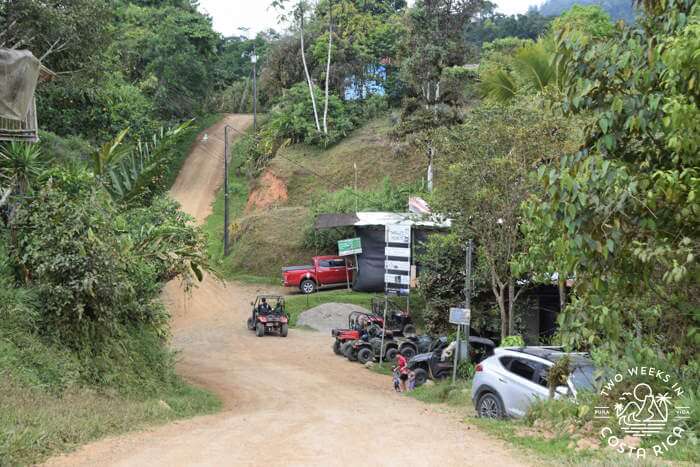
Cafe Don Emilio Tour
Introductions and Treats
As soon as we arrived, we were met by Deiner and his two little girls.
Deiner is the son of Don Emilio, the owner of the coffee farm. With a charismatic smile, he introduced our two young boys to his kids and invited us in.
We passed into the rustic building and saw a small group of tourists seated around a big wooden table, all ready to begin the tour.
In true pura vida fashion, we didn’t rush to start and all got to enjoy some homemade treats.
Deiner’s mother had prepared chocolate banana bread, which we enjoyed along with some of their coffee. The banana bread had green swirls, the result of a new technique she was trying which used spinach to turn the batter green. It was not only beautiful but delicious too.
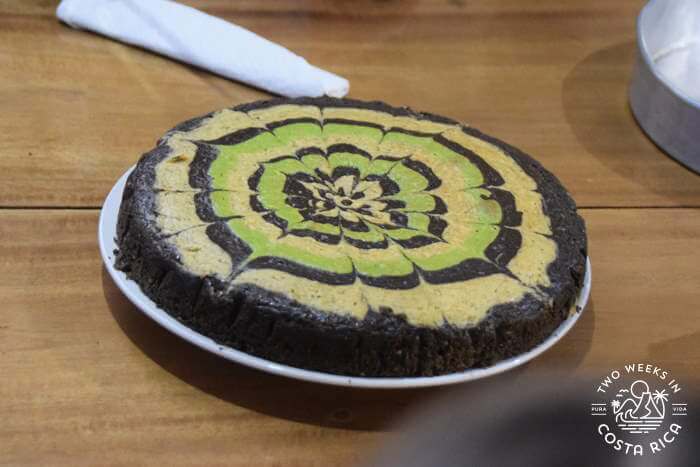
With everyone fed and happy, we followed Deiner to the coffee fields.
Coffee Process
Germinating the Plants
Finding some shade, Deiner explained a bit about the history of coffee in Costa Rica and the details about how it is grown.
We learned that to germinate coffee plants, they put small holes in wooden planks and place a bean in each one. Once sprouted, they take two babies and plant them in a shady spot (in case one dies). In about a year, the plants will mature. Then in two more years, they will begin producing coffee cherries. The same plant can be harvested for six more years, then at year nine, it needs to be cut. In two more years, it will start producing again and the cycle will continue.
Picking Coffee
To get a closer look, we climbed up into a row of coffee plants. Grabbing onto a leafy green branch, Deiner showed us how coffee cherries are harvested.
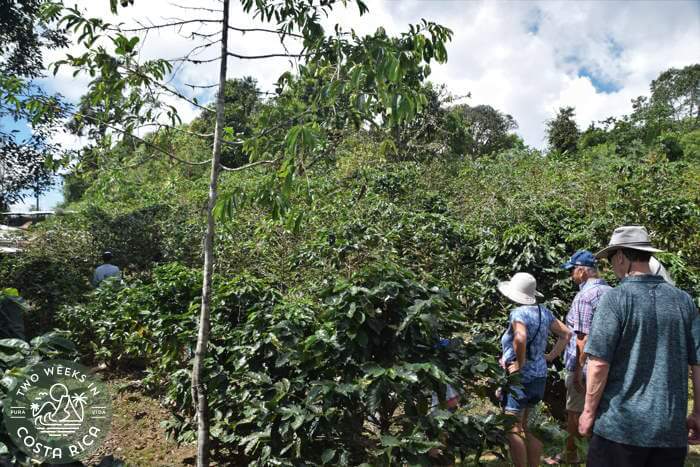
Like many things in Costa Rica, at Cafe Don Emilio, they use what they already have and keep it simple. For harvesting, they tie a plastic basket around their waist. This frees up their arms so they can pick faster with two hands.
Insects
Deiner challenged us to a picking contest to see how well we would do.
As he was going along, he came to a coffee cherry with a small hole. Inside, he found a tiny insect called a broca in Spanish. This, he explained, was a constant problem for them. When these insects get inside the beans, they can’t use them anymore. The broca lays 30-100 eggs in just four weeks so can really do some damage to their harvest.
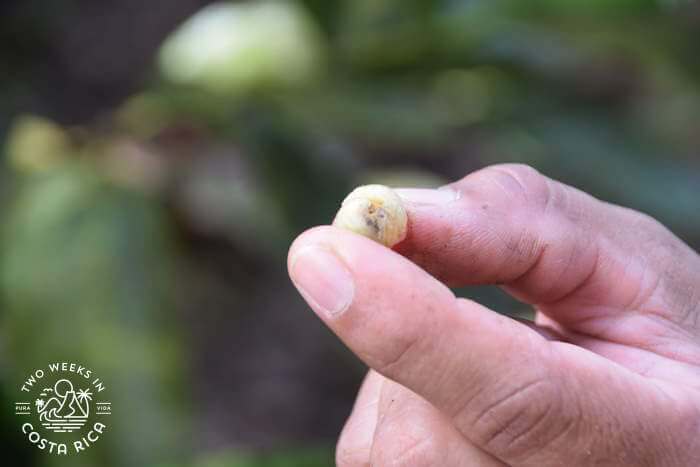
Because of this, they have to carefully spray the coffee plants with pesticides. The spray they use can’t be too strong because then it would kill the bees too. He said it is very difficult to have truly organic coffee in Costa Rica because of the insects.
Sorting and Drying – Natural Honey Process
After the coffee beans are picked, they put them in water for three to four days. This is a simple way to separate the bad beans, as they will float.
They then dry the beans on tarps in the sun. At Cafe Don Emilio, they use the natural honey process. For this method, they dry the whole fruit with the skin and flesh of the coffee cherry still intact. Other drying methods remove the outer layers first. The honey process, Deiner explained, takes longer but results in sweeter, less acidic coffee.
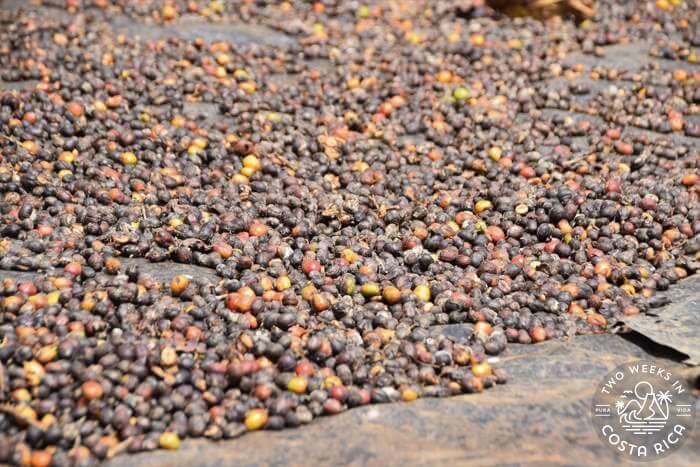
Removing the Husk
After the beans are dried, the husks need to be removed.
Previously, Don Emilio would have to use a heavy mortar and pestle to get the husk off. This worked, but was very labor intensive, as they needed to hit the dried beans about 300 times to get the shell removed.
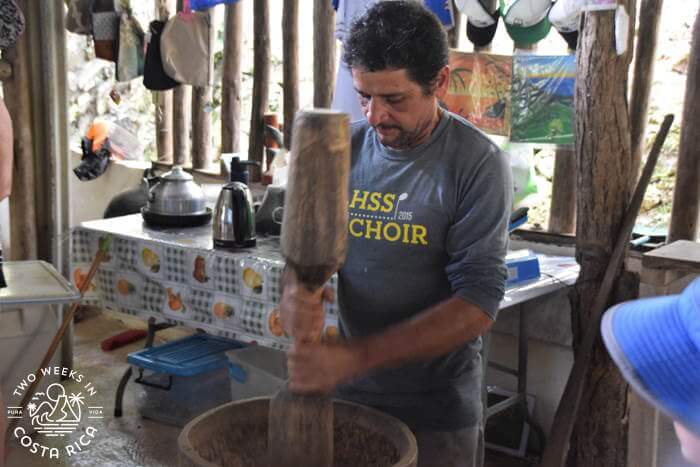
To solve this problem, Emilio made a device using a bicycle wheel. It takes several times, but the homemade machine does a very good job.
After living in Costa Rica for several years now, we have seen first-hand how innovative Costa Ricans can be. They really are great at using what they have on hand and making something out of nothing. In the example of the bicycle wheel machine, this definitely holds true.
After this step, the coffee beans are separated but still mixed with the husks in one container.
To separate out the shells/husks, they use an old-fashioned method: the wind and a bucket.
When the mixture is thrown into the air, the heavier beans fall back into the bucket. The lighter shells are swiftly blown away by the wind coming up the mountain. He invited each of us to try this clever method at a scenic spot overlooking the ocean (see cover photo).
With clean beans, it was finally time to roast.
Coffee Roasting
The story of Cafe Don Emilio’s coffee roasters is very interesting. Since roasting machines need to be imported, the cost is extremely high. So Deiner and his father, Emilio, set off to find a more affordable option.
In another example of Costa Rican ingenuity, they had a machinist in a nearby city make them roasters out of old parts like a motorcycle’s glass headlight, a washing machine transmission, etc. The roasters may be simple, but they function as they should, and we can attest to the quality of the delicious coffee they help make.
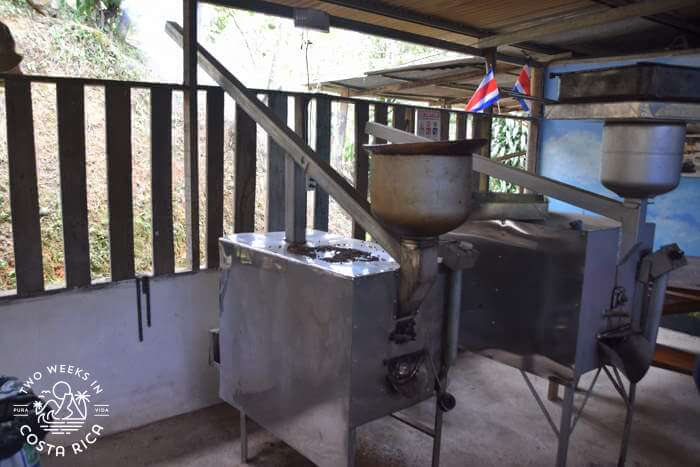
After learning about the coffee roasters, Deiner did a demonstration for us, explaining the difference between medium and dark roast.
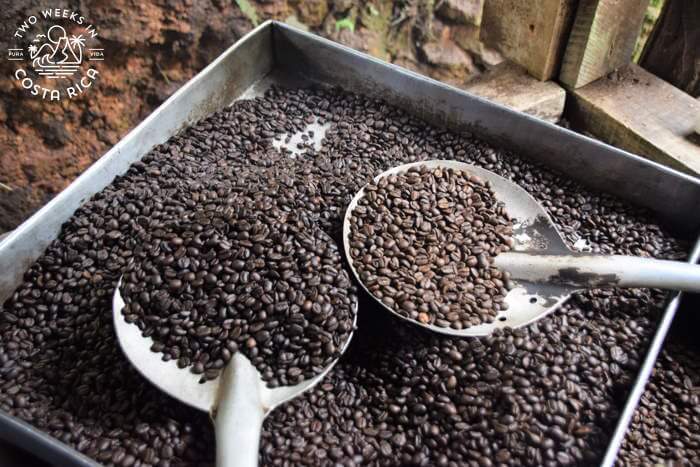
Bean Selection
Even after roasting, there’s still work to be done. Any remaining shell needs to be manually removed by hand.
They then do the coffee selection. Coffee beans have four sizes for four levels of quality. The largest is best. But if you do a honey roast, the taste will be same no matter the size.
You also check for any bad beans at this stage. Deiner told us that the cheapest coffees you can buy at stores probably contain bugs or even frog poop, which is covered up with sugar, acid, and chemicals!
Tasting a Cup
With all that knowledge about coffee, Don Emilio served us another delicious cup, which we appreciated even more the second time.
Deiner’s wife and mother then prepared a traditional lunch. It was a casado, with chicken right from the farm, rice and beans, and picadillo (a warm chopped-vegetable salad). Everything was served family style at a big table.
They topped off the tour with fresh pineapple and a shot of moonshine made from sugar cane. It tasted a bit like firewater, but we still enjoyed it.
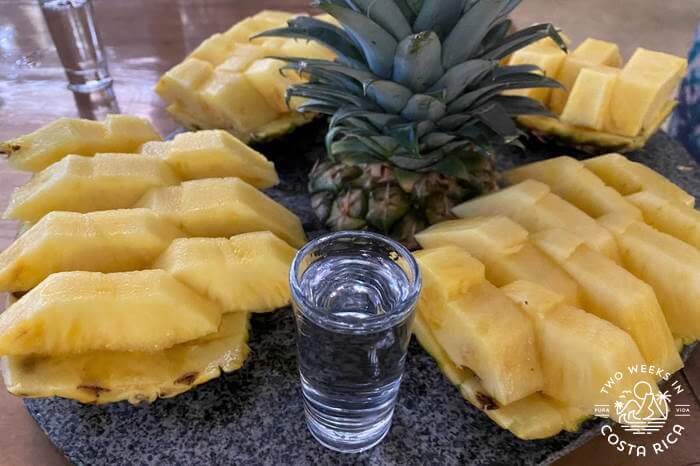
Visiting Cafe Don Emilio
Tour Times
Tours are offered Monday, Tuesday, Thursday, Friday, and Sunday at 10:00 a.m. and 2:00 p.m.
Cost
$40 per person adults. Kids ages 9 and under are free.
Duration
About 3 hours
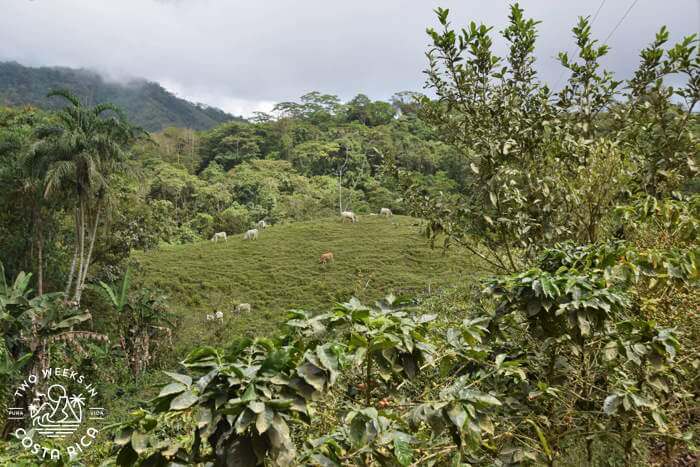
Booking a Tour
Tours are available with prior reservations only.
You can contact Deiner at Cafe Don Emilio directly to reserve a tour. His email is cafedonemilio8(at)gmail(dot)com
Or send them a message on their Facebook page.
Getting There
From the Costanera (Highway 34), take the road inland to San Luis. This is almost across the street from Rancho La Merced. From this point, the drive to Cafe Don Emilio will be about 30 minutes.
This road will take you up into the mountains. It starts paved and curvy but soon changes to rough dirt. When you get to a bridge, you’re close. After the bridge, the road becomes steep. We recommend a 4×4 vehicle at all times of year and definitely in rainy season (May through early December).
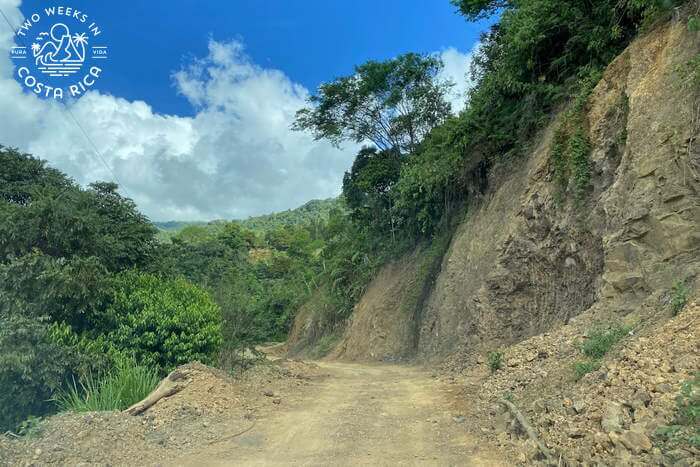
Note: We lost cell phone service shortly after turning onto the mountain road. It’s best to take screenshots of the route in advance, as there are a couple of intersections where it’s unclear which way to go.
Conclusion
Cafe Don Emilio was one of the most authentic coffee tours we’ve done in Costa Rica. By the time we left, we all felt like we were part of the family. If you’re looking to connect to the local culture, we highly recommend it.
Have a question about the Cafe Don Emilio tour? Ask us below?
Looking for more information to plan your trip to the Uvita/Dominical area? Here are some posts:
The Costa Ballena: Uvita, Dominical, and Ojochal – Our guide to this region of Costa Rica. Covers other fun activities nearby like waterfalls, nature hikes, and surfing.
Uvita Waterfall: Catarata Uvita – Learn about one of the easiest-to-access waterfalls in the area.
Manuel Antonio Bee Farm: This is another authentic tour in the Quepos/Manuel Antonio area that could be done on a day trip from Uvita.
